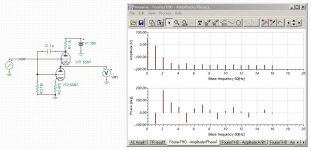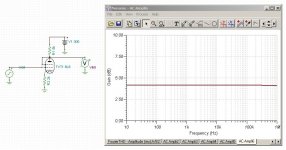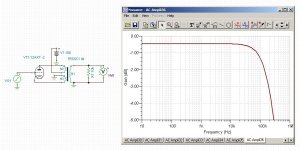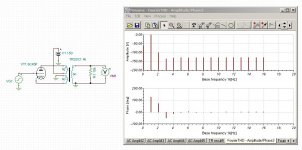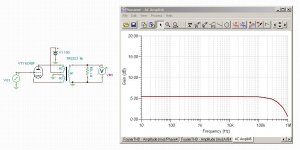I don't have a problem with the cathodyne myself. You'd need a high Gm tube to use it as an output device though.
Since the White cathode follower is push pull, will it cancel all that sweet 2H?Yes, it is a White Follower, which is an excellent driver in my opinion.
I have no opinion about triode vs. pentode and large amounts of feedback vs. less amounts. All I know is that in single ended operation, both pentodes and triodes have the second harmonic dominant in their distortion spectrums, so they should sound equally sweet to the ear, though the degree of sweetness may be different depending on topology and specific tube type selection.
I don't have a problem with the cathodyne myself. You'd need a high Gm tube to use it as an output device though.
6J9P in triode should work for that. If you give it 10mA or more, it should get 30+ mA/V.
The biggest problem with the cathodyne that I can see is that if the cathode winds up at +130V, I'd need a separate heater winding so I could lift that tube's heater supply +80V or so above ground. That could be a blessing in disguise, though. If a separate transformer is used for the heater, then it's less likely that RF will be coupled from the HT winding to the heater winding.
The other problem is that I don't know how to get the gain down to below 10X from a common-cathode triode stage. If I use 6SN7, 5687 or 6N6P, I'm likely to get 14X gain or more.
Last edited:
30+mA/V seems a bit high for 6j9p; have you looked at the (measured) data at klausmobile? You could probably achieve this from 6j11p or 6j43p.
If you like Soviet valves 6s19p has a mu of 2, triode connected 6p41s a mu of 5 and triode 6p18p a mu of about 10.
If you like Soviet valves 6s19p has a mu of 2, triode connected 6p41s a mu of 5 and triode 6p18p a mu of about 10.
Since the White cathode follower is push pull, will it cancel all that sweet 2H?
It should be fine. See the attached FFT of a 6SN7 White Follower.
Attachments
The other problem is that I don't know how to get the gain down to below 10X from a common-cathode triode stage. If I use 6SN7, 5687 or 6N6P, I'm likely to get 14X gain or more.
Maybe think outside the box? As was mentioned, use a very low mu tube, in this case a 6L6 triode connected. Also, use a lot of degeneration. THD is 0.02% or so. Gain is 4 dB.
Attachments
I am dealing with this issue as well on a 6v6 preamp I am building. I am currently of the mindset of putting a buffer on the output of a 6v6 gain stage, with volume control sandwiched between the two, using a simple line out transformer for SE to balanced.
Why put the volume control after the gain stage? Usually, it's before it. Your high output CD player could overload the gain stage, or at least drive it into higher distortion.
I had planned on trying it both ways, but in between, you have the beenfit of attenuating the distortion as well as lowering the volume. Perhaps bad thinking. I am open to anything. I had considered putting an input tansformer at the inputs of my dual mono power amps instead, but like the idea of balanced cabling, as I will have a long run to th eamps.
I don't understand how placing the volume control after the gain stage could lower distortion. Distortion output from a gain stage is typically proportional to the signal level, so the lower the level in the gain stage, the less distortion will be output.
If you have a long cable run, then yeah, an output transformer on your preamp and an input transformer on the amps is a good idea. This is the way the pro's did it a long time ago. How you drive the transformer is up to you.
As was said earlier, in theory, a cathodyne phase splitter could be used as an output driver in place of an output transformer. Alternatively, the cathodyne could drive push-pull followers, or a circlotron output.
There are many possibilities, and one is not necessarily better than the other. My preference is for simplicity, reliability and non-fussy designs.
If you have a long cable run, then yeah, an output transformer on your preamp and an input transformer on the amps is a good idea. This is the way the pro's did it a long time ago. How you drive the transformer is up to you.
As was said earlier, in theory, a cathodyne phase splitter could be used as an output driver in place of an output transformer. Alternatively, the cathodyne could drive push-pull followers, or a circlotron output.
There are many possibilities, and one is not necessarily better than the other. My preference is for simplicity, reliability and non-fussy designs.
My concern is how the cathode me phase splitter will affect the soud of the gain stage. The amp is the mbodiment of simple, being a 6v6 in triode with no feedback. It is the 6v6 preamp by Salas. Perhaps I must be thinking incorrectly about the distortion part. The amp should present an equal loa for both outputs o the cathodyne.
If you DC couple the 6V6 gain stage to the cathodyne, then the load on the 6V6 becomes the grid of the cathodyne in parallel with your plate load; so, since the grid of the cathodyne is nearly infinite impedance, then it should not affect the gain or "sound" of the 6V6 at all.
Look Ma! No resistors!
Well dang. This looks like fun, if you need attenuation of course... THD is 0.007% or so, even at 20 Hz!
Ooops, my bad. The currents flow in the same direction in the primaries... dang it. sorry about that!
If you got a custom transformer made such that the cathode winding was 50% of the primary winding, and used a high Gm tube like a 6S45P, then you'd get something really awesome with 6 dB of gain.
Well dang. This looks like fun, if you need attenuation of course... THD is 0.007% or so, even at 20 Hz!
Ooops, my bad. The currents flow in the same direction in the primaries... dang it. sorry about that!
If you got a custom transformer made such that the cathode winding was 50% of the primary winding, and used a high Gm tube like a 6S45P, then you'd get something really awesome with 6 dB of gain.
Attachments
Last edited:
I have an old chassis in mind for this, with one octal socket, maybe for a 6SN7, and two 9-pin sockets which could be used for triode-wired pentode cathodynes.
Re: 6J9P gm: Yes, I was going by a chart I saw on the Bartola website. Checking out Klausmobile's measurements, it looks like 20mA/V is more realistic from the 6J9P-triode. I also have some 6J52P. That should get 35mA/V. The only problem is microphonics, but I could do battle with that as a learning experience.
Why is the highest possible transconductance necessary? For lowest Zout? My understanding is that higher current sunk through the driver will overcome cable capacitance, so I'm aiming for 10mA to 20mA through the output stage. Since the input resistance of my power amp is pretty high (I figure 100k minimum), I should be able to get away with a Zout of 5k ohms or less before high frequency loss becomes a problem. I figure all I need is within -0.5dB to 200kHz, which shouldn't be a problem. (The volume control will be before the input of the line stage.) Any cathodyne should get Zout well below 1k ohms. If I get gm of 20mA/V, that would be a Zout of 50 ohms. Even a lowly gm of 5mA/V should yield a Zout of 200R. How low do I really need to go?
Re: DC-coupling of gain stage to cathodyne: That would be my choice, for sure. I think I'm going to use separate transformers for the heaters, so I can lift the heater supply for the cathodyne's separately from the gain stage heaters. That would make DC-coupling much easier.
Re: low-mu -- If I punch two more holes for 9-pin sockets, I could use 6P1P-triode (9-pin mini equivalent to 6V6) for the gain stage, and use 6J52P or something for the cathodyne stage. That would require a beefy power supply, what with the 6P1P needing 25mA and the 6J52P needing 15mA, times two for stereo.
I wouldn't use 6L6 in triode, because of disappointing experiences with them in push-pull triode amps. I think I just don't 'like the sound' of that tube in triode. But I do like 6V6, so that would work for me.
Is the consensus that a differential-pair running into cathode followers would be less desirable than a cathodyne? Both require four tube sockets, assuming I use twin-triodes for the diff+CF solution.
All are possibilities, once I've settled on the basic topology.
--
Re: 6J9P gm: Yes, I was going by a chart I saw on the Bartola website. Checking out Klausmobile's measurements, it looks like 20mA/V is more realistic from the 6J9P-triode. I also have some 6J52P. That should get 35mA/V. The only problem is microphonics, but I could do battle with that as a learning experience.
Why is the highest possible transconductance necessary? For lowest Zout? My understanding is that higher current sunk through the driver will overcome cable capacitance, so I'm aiming for 10mA to 20mA through the output stage. Since the input resistance of my power amp is pretty high (I figure 100k minimum), I should be able to get away with a Zout of 5k ohms or less before high frequency loss becomes a problem. I figure all I need is within -0.5dB to 200kHz, which shouldn't be a problem. (The volume control will be before the input of the line stage.) Any cathodyne should get Zout well below 1k ohms. If I get gm of 20mA/V, that would be a Zout of 50 ohms. Even a lowly gm of 5mA/V should yield a Zout of 200R. How low do I really need to go?
Re: DC-coupling of gain stage to cathodyne: That would be my choice, for sure. I think I'm going to use separate transformers for the heaters, so I can lift the heater supply for the cathodyne's separately from the gain stage heaters. That would make DC-coupling much easier.
Re: low-mu -- If I punch two more holes for 9-pin sockets, I could use 6P1P-triode (9-pin mini equivalent to 6V6) for the gain stage, and use 6J52P or something for the cathodyne stage. That would require a beefy power supply, what with the 6P1P needing 25mA and the 6J52P needing 15mA, times two for stereo.
I wouldn't use 6L6 in triode, because of disappointing experiences with them in push-pull triode amps. I think I just don't 'like the sound' of that tube in triode. But I do like 6V6, so that would work for me.
Is the consensus that a differential-pair running into cathode followers would be less desirable than a cathodyne? Both require four tube sockets, assuming I use twin-triodes for the diff+CF solution.
All are possibilities, once I've settled on the basic topology.
--
Why is the highest possible transconductance necessary? For lowest Zout? How low do I really need to go?
--
Yeah, basically. The lower the better, usually. Also, since you're not using loop feedback to lower the output impedance, then you need to compensate by using higher Gm tubes in the cathodyne, assuming it is the output device.
As I said, there are many possibilities, none are necessarily wrong. Right now, I think the "Look Ma! No resistors" is a cool circuit. Of course, a custom transformer is going to be at least $100 (probably much more) each... sigh.
Last edited:
Look Ma! no resistors and no distortion!
Ah, the 6S45P/437A.... With a cathode winding @ 50% of the turns of the primary, THD is less than -100 dB (0.0009% @ 1 kHz) for 6 dB of gain and 1 volt p-p input. Dang. One tube. One transformer. Balanced output. How much more simple can it get?
Of course, the ultrapath feedback network could be added to this to increase bass performance even more...
Ah, the 6S45P/437A.... With a cathode winding @ 50% of the turns of the primary, THD is less than -100 dB (0.0009% @ 1 kHz) for 6 dB of gain and 1 volt p-p input. Dang. One tube. One transformer. Balanced output. How much more simple can it get?
Of course, the ultrapath feedback network could be added to this to increase bass performance even more...
Attachments
Last edited:
What is the effective bandwidth of the coupling transformer when attempting to pass the maximum signal?
What is the effective bandwidth of the coupling transformer when attempting to pass the maximum signal?
That is difficult to say, since I don't have accurate transformer specifications to put into the simulator. Results will vary from those shown, depending on who makes the transformer. I made some "educated" guesses based on the data sheets from various manufacturers.
Attachments
Ah, the 6S45P/437A.... With a cathode winding @ 50% of the turns of the primary, THD is less than -100 dB (0.0009% @ 1 kHz) for 6 dB of gain and 1 volt p-p input. Dang. One tube. One transformer. Balanced output. How much more simple can it get?
Nice! I like it!
Much like a power amp, though, the results will be dependent on the quality of the transformer... Right? If so, that means it will cost. As usual, I want great performance, uses tubes, and cheap. Pick two.
I think I'll go for uses tubes and cheap, and try to maximize the performance of that combination.
6J52P-triode is pretty close to 6S45P.
6J9P-triode is pretty close to 417A or 5842.
6S3P looks good (gm = 18mA/V, mu = 40, rp = 2.5k)
6e5P-triode is well-regarded. Should have gm = 20mA/V or thereabouts
6N30P with two sections paralleled would have gm = 25mA/V
Any of those should make a decent cathodyne output stage. (Again, I won't be loading only one output. Always balanced.)
If theoretical Zout of 6J9P-triode is 50R, and paralleled-6N30P is 40R, how much difference would be there be between the two, when driving a 10k load? I would think hardly any difference at all, but I don't know...
--
Last edited:
- Status
- Not open for further replies.
- Home
- Amplifiers
- Tubes / Valves
- Unbalanced In > Balanced Out line amp - How To Do It?
